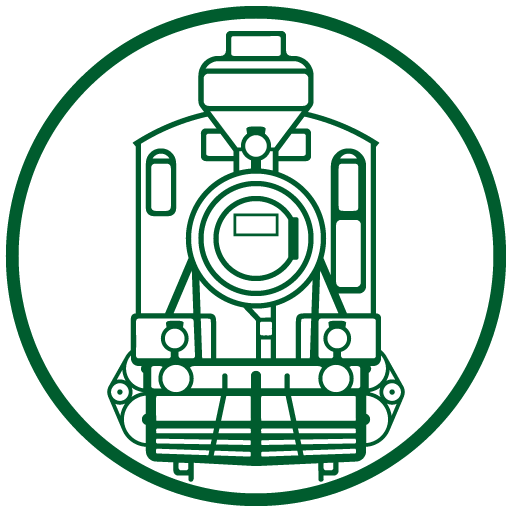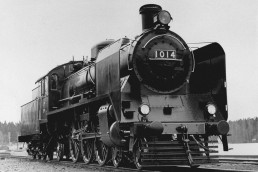By the mid-1930s it was becoming increasingly evident that the 4–6–0s of classes H8 and H9 acquired between 1915 and 1933 were less and less able to cope with the ever heavier train loads, the higher speeds and the greater frequency of stops required in daily service. To deal with this situation, two express passenger engines, large in comparison with previous VR locomotives, were ordered from Lokomo in 1936; these were followed by a further twenty locomotives built to this design between 1937 and 1957. Tampella erected nos. 1000–1011 and 1020–1021, and Lokomo nos. 1012–1019. Initially designated class P1, they were reclassified Hr1 in 1942.
The P1s had a four-wheel front bogie (with side play) and a two-wheel Adams trailing truck. As built, the axle bearings had forced feed lubrication. These superheated, two-cylinder engines used Walschaerts valve gear with piston valves. The locomotive had bar frames, air brakes and an eight-wheel bogie tender was attached. The boiler, considerably larger than any fitted previously, earned the Pacifics a great reputation as free steaming locomotives. The engines had an electric lighting and were built for coal firing.
There were differences between the various locomotives within the class itself due to technical developments over the two decades during which the class was built. The construction methods of the later engines in the series were considerably improved by the introduction of welding techniques. Lower reservoir lubrication replaced the forced feed lubrication system for the axle bearings of nos. 1006–11 whilst roller bearings replaced the plain bearings used in the leading bogie, trailing truck and tender wheels of nos. 1012–1019. These latter engines were also equipped with front window heaters and wipers. Roller bearings were used for the driving axles and main rods of nos. 1020 and 1021. Engines built from no. 1012 onwards were fitted with Müller pressure equalising piston valves instead of ordinary piston valves. The water capacity and structural design of various tenders differed according to the builder.
The outward appearance of the P1/Hr1 4–6–2s not only differed from previous classes in size but also because they carried smoke deflectors. The standard large deflectors of no. 1014 were replaced in 1956 with the small Witte type, which were also fitted new to nos. 1020 and 1021. Both the Hr1 and its 2-8-2 freight version Tr1 used interchangeable standard components and, as a consequence, an Hr1 boiler or tender might easily end up on a Tr1, or vice-versa, after workshop overhauls.
In 1938 a door giving access to the running plate was fitted on the fireman’s side of the cab of nos. 1001 and 1002. This subsequently became a standard fitting on all the Pacifics when constructed. Nos. 1000–1005 were converted to wood burning in the spring of 1945 but reverted to coal firing the following November. No. 1005 was oil fired between 1948 and 1950; however, this experiment produced negative results, with particular complaints about poor steaming. Müller pressure equalising piston valves were fitted to nos. 1000–1011 between 1954 and 1956. The leading bogie brakes were removed in the 1950s. A round front window with a heater, a type commonly found on ships, was
experimentally fitted to no. 1004 in the 1960s. The Kouvola stud of Hr1s, nos. 1017–1021, had window washers fitted during the 1960s.
The plain bearings used by Hr1 class tenders were a source of constant problems; to counteract the overheated bearings and seizures, different lubrication systems were tried. The problem was only effectively solved in 1953 when the tenders of Hr1 class nos. 1001–1011 were exchanged for the roller-bearing tenders of the latest batch of Tr1 class 2–8–2s, nos. 1061–1080.
The Hr1 Pacifics were the premier express motive power on the VR between 1949 and 1963, mainly used in southern Finland where they dominated the Helsinki–Tampere and Helsinki–Kouvola crack expresses; they also hauled express freight from the early 1960s. The Hr1 class was transferred elsewhere after their turns were taken over by diesels and other lines were upgraded by the laying of K43 and K54 rail. The Hr1s were then used on the Kouvola–Imatra/Vainikkala, Kouvola–Kuopio and Haapamäki–Pieksämäki–Joensuu routes. Their final regular rosters were the secondary passenger trains on the Helsinki–Riihimäki–Tampere and Kouvola–Pieksämäki lines. The Hr1 swansong came in the spring of 1974 when for a brief period nos. 1020 and 1021 worked passenger trains on the Seinäjoki–Vaasa line. The Hr1s were withdrawn from service between 1968 and 1974 and were then stored in strategic reserves of steam engines until 1984 when it was decided to abandon these altogether.














